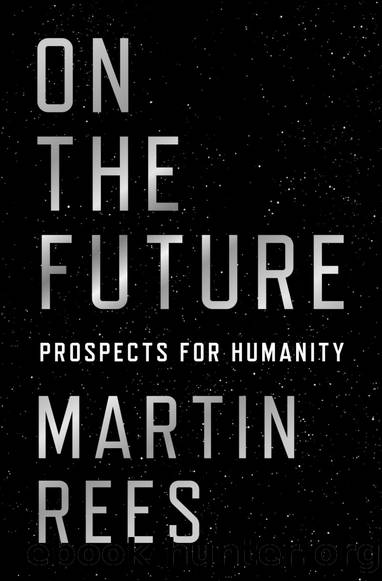On the Future: Prospects For Humanity by Martin Rees

Author:Martin Rees [Rees, Martin]
Language: eng
Format: epub
ISBN: 9780691184401
Google: wT1hDwAAQBAJ
Publisher: Princeton University Press
Published: 0101-01-01T00:00:00+00:00
3.2. BEYOND OUR SOLAR SYSTEM
To find promising âreal estateâ on which life can exist, we must extend our gaze beyond our solar systemâbeyond the reach of any probe we can devise today. What has transformed and energised the whole field of exobiology is the realisation that most stars are orbited by planets. The Italian monk Giordano Bruno speculated about this in the sixteenth century. From the 1940s onward, astronomers suspected he was correct. An earlier theory that the solar system formed from a filament torn out of the Sun by the gravitational pull of a close-passing star (which would have implied that planetary systems were rare) had by then been discredited. This theory was superseded by the idea that when an interstellar cloud contracted under gravity to form a star, it would, if it were rotating, âspin offâ a disc whose constituent gas and dust would agglomerate into planets. But it wasnât until the 1990s that evidence for exoplanets started to emerge. Most exoplanets are not detected directly; they are inferred through careful observation of the star theyâre orbiting. There are two main techniques.
The first is this. If a star is orbited by a planet, then both planet and star move around their centre of massâwhatâs called the barycentre. The star, being more massive, moves slower. But the cyclic motion induced by an orbiting planet can be detected by precise study of the starlight, which reveals a changing Doppler effect. The first success came in 1995 when Michel Mayor and Didier Queloz, based at the Observatory of Geneva, found a âJupiter-massâ planet around the nearby star 51 Pegasi.3 In the subsequent years, more than four hundred exoplanets have been found in this way. This âstellar wobbleâ technique pertains mainly to âgiantâ planetsâobjects the size of Saturn or Jupiter.
Possible âtwinsâ of Earth are specially interesting: planets the same size as ours, orbiting other Sun-like stars, on orbits with temperatures such that water neither boils nor stays frozen. But detecting theseâhundreds of times less massive than Jupiterâis a real challenge. They induce wobbles of merely centimetres per second in their parent starâthis motion has hitherto been too small for the Doppler method to detect (though the instrumentation advances apace).
But thereâs a second technique: we can look for the planetsâ shadows. A star would appear to dim slightly when a planet was âin transitâ in front of it; these dimmings would repeat at regular intervals. Such data reveal two things: the interval between successive dimmings tells us the length of the planetâs year, and the amplitude of the dimming tells us what fraction of the starâs light a planet blocks out during the transit, and therefore how big it is.
The most important search (so far) for transiting planets was carried out by a NASA spacecraft named after astronomer Johannes Kepler,4 which spent more than three years measuring the brightness of 150,000 stars, to a precision of one part in 100,000âit did this once or more times an hour for each star. Kepler found thousands of transiting planets, some no bigger than Earth.
Download
This site does not store any files on its server. We only index and link to content provided by other sites. Please contact the content providers to delete copyright contents if any and email us, we'll remove relevant links or contents immediately.
| Aeronautics & Astronautics | Astronomy |
| Astrophysics & Space Science | Comets, Meteors & Asteroids |
| Cosmology | Mars |
| Solar System | Star-Gazing |
| Telescopes | UFOs |
Tools of Titans by Timothy Ferriss(8311)
Turbulence by E. J. Noyes(7983)
Secrets of Antigravity Propulsion: Tesla, UFOs, and Classified Aerospace Technology by Ph.D. Paul A. Laviolette(5338)
Astrophysics for People in a Hurry by Neil DeGrasse Tyson(5153)
Room 212 by Kate Stewart(5077)
Design of Trajectory Optimization Approach for Space Maneuver Vehicle Skip Entry Problems by Runqi Chai & Al Savvaris & Antonios Tsourdos & Senchun Chai(5040)
Pale Blue Dot by Carl Sagan(4961)
The David Icke Guide to the Global Conspiracy (and how to end it) by David Icke(4660)
A Journey Through Divination and Astronomy by Publishing Pottermore(4364)
Goodbye Paradise(3772)
Apollo 8 by Jeffrey Kluger(3673)
COSMOS by Carl Sagan(3593)
The Five People You Meet in Heaven by Mitch Albom(3524)
Losing the Nobel Prize by Brian Keating(3521)
How to Read Water: Clues and Patterns from Puddles to the Sea (Natural Navigation) by Tristan Gooley(3434)
Brief Answers to the Big Questions by Stephen Hawking(3394)
How to Read Nature by Tristan Gooley(3295)
The Order of Time by Carlo Rovelli(3164)
A Brief History of Time by Stephen Hawking(2995)
